 Laguna Beach, Orange County, CA. 06/05/05. © Peter J. Bryant |
Bernardino Blue Euphilotes bernardino Lepidoptera: Lycaenidae Back to Butterflies of Orange County, California |
 Wood Canyon, Orange County, CA. 06/15/09. © Peter J. Bryant |
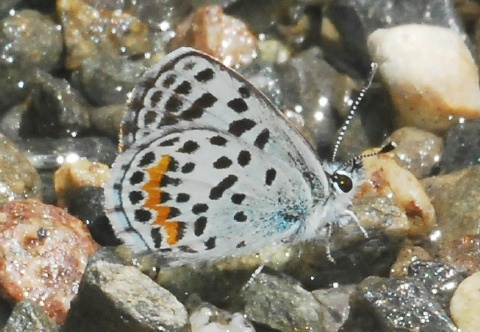 Thomas E. Riley Wilderness Park, Coto de Caza, Orange County, CA. 6-10-07. © Ron Hemberger |
 Peter's Canyon, Orange, Orange County, CA. 6-5-06. © Ron Hemberger |
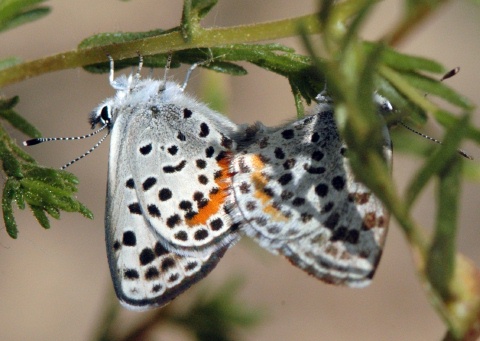 Peter's Canyon, Orange, Orange County, CA. 6-5-06. © Ron Hemberger |
 Female. Laguna Laurel, Laguna Beach, Orange County, CA. 06/15/09. © Peter J. Bryant |
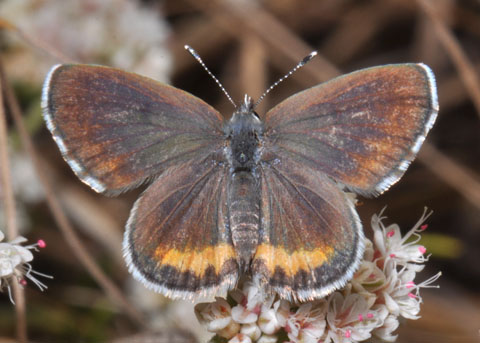 Female. Laguna Laurel, Laguna Beach, Orange County, CA. 06/15/09. © Peter J. Bryant |
 Female. Nix Nature Center, Laguna Beach, Orange County, CA. 6-8-09. © Ron Hemberger |
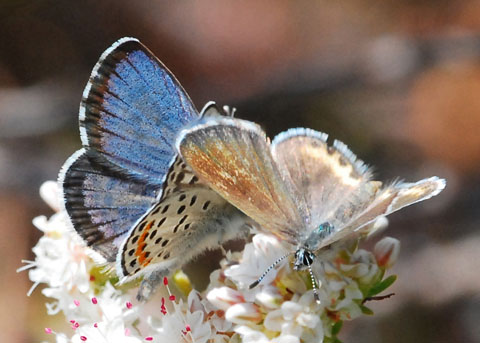 Thomas E. Riley Wilderness Park, Coto de Caza, Orange County, CA. 5-24-09. © Ron Hemberger |
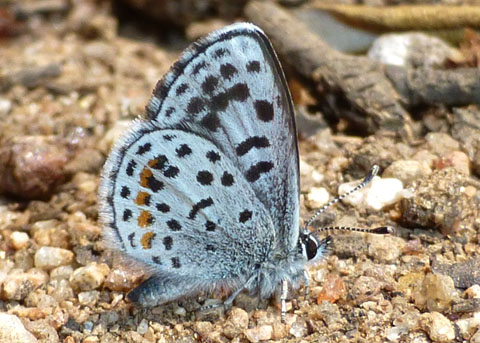 Male. Morgan Trail, Cleveland National Forest, Riverside County, CA. 5/24/13. © Peter J. Bryant. |
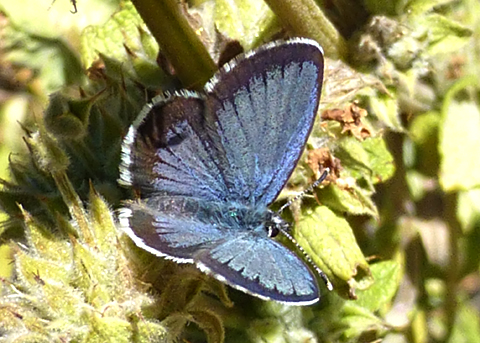 Male. Morgan Trail, Cleveland National Forest, Riverside County, CA. 5/24/13. © Peter J. Bryant. |
Characteristics: A small "blue". Ventral wing surface like that of Plebejus acmon, but without metallic scales on spots near outer margin of ventral hindwing. Male--blue on the dorsal wing surface; female--brown, with orange near dorsal hindwing margins. Forewing length: 9-11 mm. Similar Species: Exceedingly similar to Dammer's Blue which, however, is not likely to be encountered by a beginner. The Bernardino Blue also might be confused with Plebejus acmon. However, the Bernardino Blue's forewing length is smaller than that of acmon. Male bernardino differs from the acmon male by the absence of a strong orange band on the outer margin of the dorsal hindwing, replaced by a heavy black margin. The female Bernardino Blue is often almost undistinguishable from female acmon, except for the smaller size and lack of metallic spots. Habitats, Behavior: This diminutive butterfly is strongly associated with Wild Buckwheat, the larval foodplant. The Bernardino Blue is a fairly weak flyer and is often overlooked on account of its small size. Distribution: In Orange County, the species is generally distributed, but local in occurrence. Our records range from near sea level to 4310 feet (Maple Springs, Santa Ana Mtns.). Lowland colonies have been largely wiped out by habitat destruction. Flight Period: One brood flies from late April into mid July, depending upon elevation. We also have an exceptionally early record from the middle of March. Langston (1974) discusses the phenomenon of longer flight periods for coastal populations when compared to populations occurring inland. In Orange County, coastal populations of bernardino do seem to fly much later than inland populations at comparable elevations. Larval Foodplants: Eriogonum fasciculatum, (Wild Buckwheat), including subspecies foliolosum and polifolium (Emmel and Emmel, 1973). Eriogonum fasciculatum ssp. fasciculatum is the suspected foodplant in Orange County. Eriogonum parvifolium is a possible foodplant at Scotchman's Cove and at other coastal bluff locations. The larvae are flower feeders and are well camouflaged. Other Remarks: The Bernardino Blue rarely strays from its larval foodplant. Careful observations are needed before we can determine if bernardino is generally distributed wherever E. fasciculatum grows, or is of spotty distribution in these areas, due to some unknown limiting factor(s). Theodore Hower mentions that individuals from coastal Orange County populations are somewhat different in appearance than those from inland populations. The phenotype of specimens from coastal populations should be compared with specimens of the endangered El Segundo Blue (S. b. allyni), a named subspecies of battoides, found only in a few remnant coastal sand dune localities in Los Angeles County. The Bernardino Blue was placed in the genus Philotes until the recent completion of comparative studies by Shields (1975). Further Information: Langston (1965) reviews the distribution and foodplants of this subspecies. Shields (1975, 1977) are the latest treatments of the species as a whole. From Orsak, L. J. (1977). The Butterflies of Orange County, California. Center for Pathobiology Miscellaneous Publication #3. University of California Press, New York. 349pp. Return to Butterflies and their larval foodplants |
|
